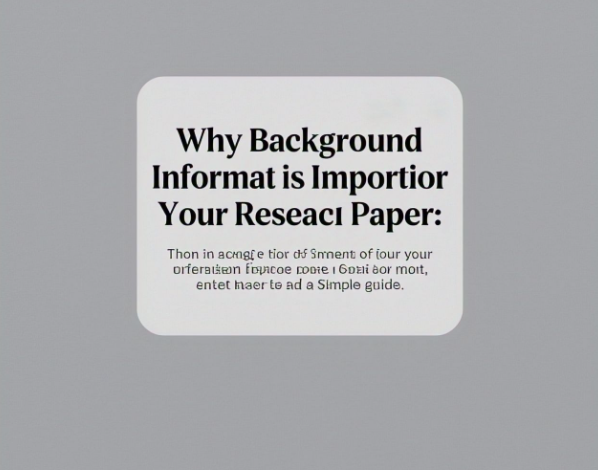
Understanding background information is one of the first steps to writing a successful research paper. It helps you get a good grasp of your topic before diving deeper into detailed research. Background information provides the necessary context, helping you understand the history, key concepts, and important facts about your subject. This foundation helps you make sense of more complex information later on.
Without enough background information, your research might feel confusing or unclear. It’s like trying to build a house without knowing what type of foundation you need. This part of your paper shows readers that you understand the topic well, making them more confident in your research and findings. Let’s explore why this is important and how to gather the right background information for your research paper.
Table of Contents
What is Background Information and Why It Matters
When you’re starting a research paper or project, understanding background information is the first step. It’s like getting a map before going on a trip. Background information gives you an overview of your topic. It tells you the history, the main ideas, and what others have already said about the topic. Without this, it would be hard to know where to begin.
Why is it important? Because it helps you understand the big picture. You can see the key concepts, and how your research fits into what others have studied. It also helps you get ideas for your research question or problem. Knowing the basics first makes it easier to dive deeper into more complicated details later on.
How to Use Background Information in Your Research Paper
Once you have background information, you can use it to shape the rest of your paper. Start with a good introduction. You can introduce your topic by sharing key facts or historical details that help explain why your research is important. This way, your readers will understand your topic before you start explaining it in detail.
Using background information in your paper also helps you build a strong argument. When you know what others have said about your topic, you can refer to it in your paper. This shows your readers that you have done your homework and understand the subject. It also helps you support your own ideas and opinions with facts.
Types of Background Information You Need for a Strong Paper
There are different types of background information you might need. Some of it comes from general sources, like encyclopedias or websites, and some of it is from research articles. General facts or a timeline can help you set the scene. For example, if you’re writing about the history of space exploration, you might include basic facts about the first moon landing.
Other types of background information include theories or studies that have already been done. These help you see what has been learned before and where your research might fit. For example, you could look at scientific papers or books that explain different ideas about your topic. This helps you avoid repeating what others have already found.
Where to Find Reliable Background Information
Finding background information is easy if you know where to look. Libraries and online databases are some of the best places to start. You can use encyclopedias, academic journals, and books that are trusted by experts. Websites from universities or government organizations can also be useful, but be careful to avoid unreliable sources.
Some great online resources include Google Scholar, where you can find academic articles, and websites like Credo Reference, which provide helpful summaries and facts on many topics. Make sure to choose sources that are trustworthy and have been reviewed by experts. This ensures that the information you’re using is accurate and reliable.
How Background Information Helps Shape Your Research Question
Once you’ve gathered enough background information, it’s easier to narrow down your research question. The more you learn, the clearer your specific topic becomes. For example, after reading about climate change, you might decide to focus on how it affects coastal cities, rather than just discussing climate change in general.
Background information also helps you spot gaps in current research. You might find that certain questions haven’t been fully answered, which could lead to your own research question. This is a key step in ensuring your paper makes a new contribution to the field and adds value to the existing research.
Spotting Gaps in Research with Background Information
As you dive into background information, look for areas that haven’t been explored much. These gaps might be questions that need more research or aspects of the topic that haven’t been fully studied. When you find these, you can focus your paper on answering these unanswered questions. This makes your work more interesting and valuable to others.
Common Mistakes to Avoid When Using Background Information
While background information is useful, it’s important to use it correctly. One common mistake is relying too much on one source. It’s important to gather information from different places to get a balanced view of the topic. Another mistake is using outdated information. Make sure to look for the most recent studies or facts, especially if your topic is something that changes over time, like technology or medicine.
It’s also important not to copy large parts of background information into your paper. You should always paraphrase and cite your sources correctly. This shows that you respect the work of others and helps you avoid plagiarism.
How to Avoid Overusing Background Information
When using background information, try not to include too much detail. Focus on the key facts and ideas that directly relate to your research. If you add too much background, it can overwhelm your readers and distract them from your main research. Keep it simple and clear, using just enough information to set the stage for your paper.
Connecting Background Information to Your Literature Review

The background information section of your paper helps set the stage for your literature review. In the literature review, you look at what others have written about your topic. Your background information gives you the starting point for this. You can use it to introduce key studies and research that others have done.
Your literature review is a deeper look into the studies, experiments, and articles that relate to your topic. By connecting background information to the literature review, you create a smooth flow in your paper, showing your readers where the topic has been, and where your research will go next.
How to Organize Your Literature Review with Background Information
Start your literature review by using your background information to introduce key sources. Then, dive into more detailed discussions of those sources, explaining how they relate to your own research. This way, the background information is the foundation that supports your deeper investigation of the topic.
The Role of Background Information in Research Papers
Background information plays a critical role in shaping your research paper. It’s the first step that helps guide your focus and provides the necessary foundation for your study. Without a solid background, it can be difficult to know where to begin or how to structure your research. This initial information gives context to your research question and highlights why your topic is important.
When you include background information, you help readers understand the subject and its history. For instance, if you are writing about climate change, the background might discuss early studies on environmental changes and how climate science has evolved. This sets the stage for your arguments and helps you build upon past knowledge rather than repeating it.
How to Use Background Information Effectively
Using background information effectively involves more than just summarizing existing studies or facts. You should aim to incorporate it in a way that adds value to your argument. Make sure to balance general information with your original ideas, showing how your research contributes to the existing body of knowledge.
When researching background information, it’s important to select reliable and relevant sources. Books, scholarly journals, and trustworthy websites are good starting points. You can use online databases like JSTOR, Google Scholar, or your library’s resources to find credible references. Once you have gathered enough, organize the information in a clear, logical manner that directly supports your research question.
Avoid overloading your paper with too many background details. Remember, the purpose is to give just enough context to your topic. Too much information can confuse your readers, while too little can leave them uncertain about the importance of your research.
Conclusion
In conclusion, background information is an important first step in any research project. It gives you the foundation you need to understand your topic before you dive deeper. By looking at general facts, historical details, and expert opinions, you can get a clear picture of what’s already been studied and what areas still need more research.
Remember, background information helps you narrow down your research question, making it easier to focus on what’s most important. By using reliable sources and avoiding mistakes like copying too much information, you’ll be able to create a strong foundation for your paper or project. Always use it wisely and in balance with your own ideas to make your work better and more interesting.
FAQs
Q: What is background information?
A: Background information is general knowledge about a topic, including facts, history, and key ideas. It helps you understand the basics before doing deeper research.
Q: Why is background information important in research?
A: It helps you get an overview of your topic, making it easier to form questions and ideas for your research. It also shows what others have already studied.
Q: Where can I find background information for my project?
A: You can find it in encyclopedias, books, trustworthy websites, and academic articles. Libraries and online databases are great places to start.
Q: How much background information should I use in my paper?
A: Use enough to explain your topic, but don’t add too much. Keep it simple and only include information that helps your research.
Q: Can I use background information in my literature review?
A: Yes, background information helps set the stage for your literature review by introducing important studies and key ideas that relate to your topic.



